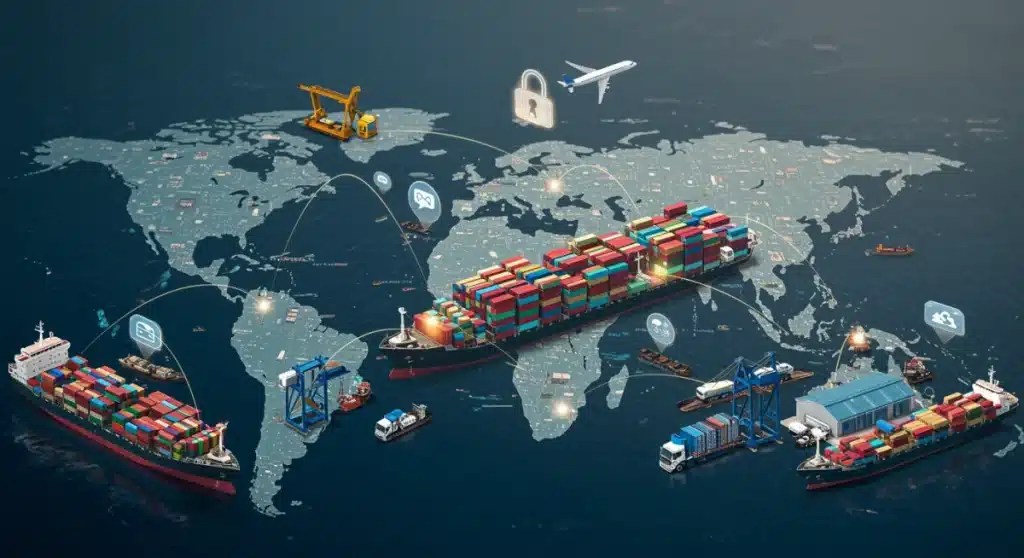Federal Policy Directives 2025: Strengthening Supply Chain Resilience

Federal Policy Directives for 2025 are targeting a 20% increase in supply chain resilience through strategic investments, enhanced data sharing, and domestic production incentives, safeguarding national economic stability and security.
As of today, new developments indicate that the Federal Policy Directives for 2025: How Supply Chain Resilience is Being Strengthened by 20% is a top priority, aiming to fortify national and international logistics against future disruptions. This initiative seeks to build a more robust and adaptive economic infrastructure.
Understanding the Mandate for Enhanced Resilience
The federal government has recently unveiled a comprehensive set of directives for 2025, specifically designed to bolster the nation’s supply chain resilience. These directives emerge from lessons learned during recent global crises, which exposed significant vulnerabilities across various sectors. The overarching goal is to achieve a measurable 20% increase in resilience by the end of 2025, a target set to ensure economic stability and national security.
This mandate is not merely a suggestion but a directive with clear implementation strategies and accountability measures. It represents a significant shift in federal strategy, moving from reactive crisis management to proactive risk mitigation and strategic foresight. The emphasis is on creating diversified, transparent, and technologically advanced supply networks that can withstand unforeseen shocks.
Key Drivers Behind the 2025 Directives
Several critical factors are driving the urgency and scope of these new directives. Geopolitical tensions, climate change impacts, and rapid technological advancements all contribute to an increasingly complex global trade environment. The federal government recognizes that a resilient supply chain is fundamental to maintaining economic competitiveness and safeguarding essential services.
- Recent Global Disruptions: The COVID-19 pandemic, trade disputes, and natural disasters highlighted critical weaknesses.
- National Security Concerns: Dependence on foreign sources for critical goods poses strategic risks.
- Economic Competitiveness: Efficient and reliable supply chains are vital for sustained economic growth.
- Technological Evolution: Leveraging new technologies for better visibility and predictive analytics.
The directives aim to address these drivers head-on, promoting a holistic approach that integrates various government agencies, private sector entities, and international partners. This collaborative effort is expected to yield a more integrated and responsive supply chain ecosystem.
Strategic Pillars of the Federal Initiative
The federal government’s plan to strengthen supply chain resilience by 20% rests on several strategic pillars, each addressing a distinct aspect of the supply chain ecosystem. These pillars include significant investments in infrastructure, enhanced data sharing protocols, incentives for domestic production, and international collaboration. Each component is critical to achieving the ambitious 20% resilience target.
These pillars are meticulously designed to create a multi-layered defense against future disruptions, moving beyond simple stockpiling to foster genuine adaptability and strength within the supply chain. The initiatives are not isolated but interconnected, forming a cohesive strategy for long-term resilience.
Infrastructure Modernization and Investment
A cornerstone of the 2025 directives is the substantial investment in modernizing critical infrastructure. This includes upgrading ports, improving transportation networks, and developing advanced logistics hubs. The aim is to reduce bottlenecks and increase the speed and efficiency of goods movement.
- Port Upgrades: Billions allocated for deepening channels, expanding terminals, and automating operations.
- Road and Rail Improvements: Funds directed towards repairing and expanding key transportation arteries.
- Digital Infrastructure: Investing in 5G and IoT technologies to enhance real-time tracking and management.
These infrastructure projects are not only about physical improvements but also about integrating smart technologies to optimize flow and predictability. The federal government emphasizes that these investments will create jobs and stimulate local economies while simultaneously strengthening the national supply chain.
Leveraging Data and Technology for Transparency
Central to the new federal directives is the pervasive integration of data and advanced technologies to foster unprecedented transparency across supply chains. The goal is to move away from opaque, fragmented systems towards a unified, visible network where potential disruptions can be identified and mitigated proactively. This technological overhaul is expected to be a primary driver in achieving the 20% resilience target.
The emphasis is on real-time data analytics, artificial intelligence, and blockchain technologies to create a more intelligent and responsive supply chain. By understanding every link in the chain, from raw materials to final delivery, stakeholders can make informed decisions and react swiftly to emerging threats.

Enhanced Data Sharing Protocols
The directives mandate the development and adoption of standardized data sharing protocols across various industries and government agencies. This initiative aims to break down data silos that often hinder effective risk management and collaborative problem-solving.
- Interoperable Platforms: Creating common data standards for seamless information exchange.
- Secure Data Lakes: Establishing secure repositories for aggregated supply chain data.
- Predictive Analytics Tools: Deploying AI-driven tools to forecast demand and identify potential choke points.
These protocols are designed to ensure that sensitive information is shared securely and efficiently, allowing for a holistic view of the supply chain without compromising proprietary data. The federal government anticipates that this increased transparency will significantly reduce response times during crises.
Incentivizing Domestic Production and Nearshoring
A critical component of the Federal Policy Directives for 2025 is the robust push towards incentivizing domestic production and nearshoring. This strategy aims to reduce the nation’s reliance on distant and potentially unstable foreign supply sources, thereby directly strengthening supply chain resilience by 20%. The federal government views this as a vital step in safeguarding national interests and economic stability.
This initiative goes beyond mere rhetoric, offering tangible benefits and support for companies willing to bring manufacturing and sourcing closer to home. It represents a long-term commitment to rebuilding domestic industrial capacity and fostering a more self-reliant economy.
Financial Incentives and Regulatory Support
To encourage this shift, the directives outline a series of financial incentives and regulatory adjustments designed to make domestic production more attractive and feasible. These measures are intended to offset higher labor costs and other challenges associated with manufacturing within the country.
- Tax Credits and Subsidies: Offering significant tax breaks and direct financial support for companies investing in U.S. manufacturing facilities.
- Streamlined Permitting: Expediting regulatory approval processes for new domestic production sites.
- Research and Development Funding: Allocating funds for innovation in key sectors to enhance domestic technological capabilities.
Furthermore, the government is exploring ‘Buy American’ provisions and other procurement policies that prioritize domestically produced goods, ensuring a consistent market for companies that reshore their operations. This comprehensive approach aims to create a sustainable environment for domestic growth.
International Collaboration and Diversification
While prioritizing domestic capabilities, the Federal Policy Directives for 2025 also emphasize the critical role of international collaboration and diversification in achieving a 20% increase in supply chain resilience. The understanding is that a truly robust supply chain cannot exist in isolation; it must be globally connected yet strategically diversified to mitigate risks.
This dual approach seeks to build strong alliances with trusted international partners while simultaneously reducing over-reliance on any single region or country for critical goods. It’s a nuanced strategy that balances global engagement with national security and economic self-sufficiency.
Forging Stronger Global Partnerships
The directives call for enhanced diplomatic efforts to forge new trade agreements and strengthen existing partnerships with allies. These collaborations aim to create more reliable and diversified sourcing options for essential goods and components.
- Bilateral and Multilateral Agreements: Negotiating new pacts focused on supply chain security and transparency.
- Joint Risk Assessments: Collaborating with international partners to identify and address shared supply chain vulnerabilities.
- Information Sharing Networks: Establishing systems for real-time exchange of supply chain intelligence with allies.
By working closely with international partners, the federal government intends to create a network of resilient supply chains that can collectively withstand global shocks, ensuring the availability of critical supplies even when one region faces disruption.
Anticipated Impact and Future Outlook
The Federal Policy Directives for 2025 are poised to significantly transform the landscape of national and global supply chains, with an anticipated 20% strengthening of resilience. This ambitious target, driven by recent vulnerabilities, aims to create a more secure, efficient, and adaptable economic infrastructure. The impact is expected to be far-reaching, affecting everything from consumer goods to national defense.
The long-term outlook suggests a more localized yet globally interconnected supply chain model, less susceptible to single points of failure. This shift will likely redefine business strategies and governmental priorities for decades to come, moving towards a proactive rather than reactive stance on supply chain management.
Economic and Security Implications
The economic implications of these directives are substantial. A more resilient supply chain is expected to lead to greater price stability, reduced inflation risks, and increased domestic job creation. Businesses will benefit from more predictable access to components and raw materials, fostering greater innovation and competitiveness.
- Enhanced Economic Stability: Reduced vulnerability to external shocks will stabilize markets.
- Job Growth: Incentives for domestic production will create manufacturing and logistics jobs.
- National Security Boost: Less reliance on adversaries for critical resources strengthens defense capabilities.
From a national security perspective, reducing dependence on potentially hostile nations for essential goods and technologies is paramount. The directives aim to ensure that the U.S. can independently produce or reliably source critical items, safeguarding its strategic interests and operational capabilities.
Challenges and Implementation Hurdles
While the Federal Policy Directives for 2025 present a clear vision for strengthening supply chain resilience by 20%, their implementation is not without significant challenges. Achieving such an ambitious goal requires overcoming complex economic, political, and logistical hurdles. The federal government acknowledges these difficulties and is preparing for a multi-faceted approach to address them.
The success of these directives hinges on effective collaboration between government agencies, private industry, and international partners. Balancing diverse interests and managing the sheer scale of the transformation will be critical for overcoming potential roadblocks.
Overcoming Resistance and Funding Gaps
One primary challenge is potential resistance from industries accustomed to existing global supply chain models. Transitioning to new sourcing strategies, whether domestic or nearshored, often involves significant upfront costs and adjustments to established practices. Furthermore, securing consistent and adequate funding for all proposed initiatives remains a persistent concern.
- Industry Adaptation: Convincing businesses to re-evaluate and restructure their supply networks.
- Funding Allocation: Ensuring sustained financial commitment across multiple budget cycles.
- Labor Skill Gaps: Addressing the need for a skilled workforce in revitalized domestic manufacturing sectors.
Another hurdle involves navigating international trade agreements and potential retaliatory measures from countries whose established supply chain roles may be disrupted. Diplomatic efforts will be essential to mitigate adverse impacts and maintain constructive global trade relations during this transition period. The directives emphasize a phased approach to allow for adaptation and minimize economic shock.
| Key Policy Area | Brief Description |
|---|---|
| Infrastructure Investment | Modernizing ports, transportation, and logistics hubs to reduce bottlenecks and improve efficiency. |
| Data & Technology Integration | Implementing advanced analytics, AI, and blockchain for increased supply chain transparency and predictability. |
| Domestic Production Incentives | Offering tax credits, subsidies, and streamlined regulations to encourage reshoring and nearshoring manufacturing. |
| International Collaboration | Forging new partnerships and agreements to diversify sourcing and share risk with global allies. |
Frequently Asked Questions About 2025 Supply Chain Directives
The main objective is to strengthen supply chain resilience by 20% by the end of 2025. This aims to reduce vulnerabilities exposed by recent global disruptions and enhance national economic and security stability.
The directives include significant incentives like tax credits and streamlined regulations to encourage companies to bring manufacturing back to the U.S. or to nearshore locations, boosting domestic production.
Technology is crucial, with mandates for enhanced data sharing, AI-driven predictive analytics, and blockchain integration. These tools aim to increase transparency and provide real-time insights for proactive risk management.
No, while domestic production is prioritized, the directives also emphasize strengthening international collaboration. They seek to diversify global sourcing and forge stronger partnerships with allies to mitigate risks from single points of failure.
Key challenges include overcoming industry resistance to change, securing consistent funding, addressing potential labor skill gaps, and navigating complex international trade dynamics to avoid adverse impacts.
What This Means
The Federal Policy Directives for 2025 represent a pivotal moment in the nation’s approach to economic security. By targeting a 20% increase in supply chain resilience, the government is signaling a long-term commitment to safeguarding vital industries and consumer access to goods. This shift will likely necessitate significant adaptation across various sectors, from manufacturing to logistics, as businesses align with new regulatory frameworks and incentive structures. Watch for ongoing legislative actions and industry responses as these directives begin to take tangible effect, reshaping the global trade landscape.





